
myCBSEguide App
Download the app to get CBSE Sample Papers 2024-25, NCERT Solutions (Revised), Most Important Questions, Previous Year Question Bank, Mock Tests, and Detailed Notes.
Install NowCBSE class 9 Science Chapter 4 Structure of the Atoms notes in PDF are available for free download in myCBSEguide mobile app. The best app for CBSE students now provides Structure of the Atoms class 9 Notes latest chapter wise notes for quick preparation of CBSE exams and school based annual examinations. Class 9 Science notes on Chapter 4 Structure of the Atoms are also available for download in CBSE Guide website.
CBSE Guide Structure of the Atoms class 9 Notes
CBSE guide notes are the comprehensive notes which covers the latest syllabus of CBSE and NCERT. It includes all the topics given in NCERT class 9 Science text book. Users can download CBSE guide quick revision notes from myCBSEguide mobile app and my CBSE guide website.
9 Science notes Chapter 4 Structure of the Atoms
Download CBSE class 9th revision notes for Chapter 4 Structure of the Atoms in PDF format for free. Download revision notes for Structure of the Atoms class 9 Notes and score high in exams. These are the Structure of the Atoms class 9 Notes prepared by team of expert teachers. The revision notes help you revise the whole chapter in minutes. Revising notes in exam days is on of the best tips recommended by teachers during exam days.
Download Revision Notes as PDF
CBSE Class 9 Science
Revision Notes
CHAPTER – 4
STRUCTURE OF ATOM
Contribution to the Atomic theory Timeline
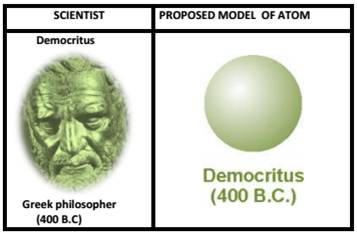
- More than 2400 years ago, he named the smallest piece of matter “ATOMOS,” meaning “not to be cut.”
- Atoms were small, hard particles that were all made of the same material but were different shapes and sizes.
- Atoms were infinite in number, always moving and capable of joining together
- Dalton’s Atomic theory:
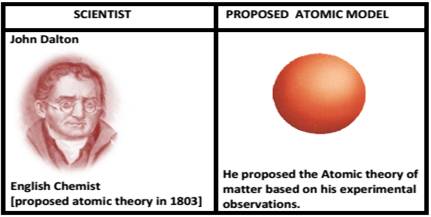
- First recorded evidence that atoms exists.
- Using his theory, Dalton rationalized the various laws of chemical combination
Dalton’s theory was based on the premise that the atoms of different elements could be distinguished by differences in their weights.
Limitations
- The indivisibility of an atom was proved wrong , for, an atom can be further subdivided into protons, neutrons and electrons.
- The atoms of same element are similar in all respects , but isotopes of same element have different mass.
- Dalton’s theory was based on the premise that the atoms of different elements could be distinguished by differences in their weights.
- J J Thomson Experiments:
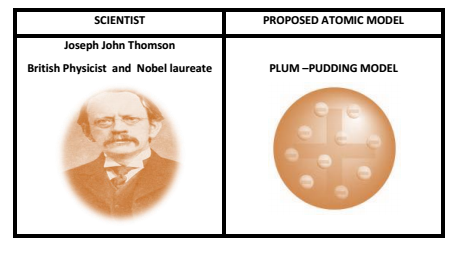
- Discovered electrons in 1897.
- Showed us that the atom can be split into even smaller parts.
His discovery was the first step towards a detailed model of the atom.
- An atom is a uniform sphere of positive charges (due to presence of protons) as well as negative charges (due to presence of electrons).
- Atom as a whole is electrically neutral because the negative and positive charges are equal in magnitude.
- An electron is a negatively charged component of an atom which exists outside the nucleus. Each electron carries one unit of negative charge and has a very small mass as compared with that of a neutron or proton.
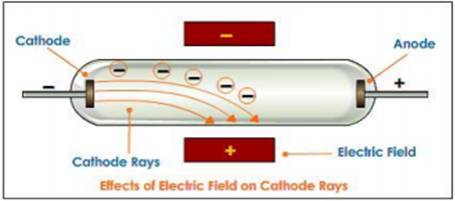
JJ Thomson used cathode ray tubes to demonstrate that the cathode ray responds to both magnetic and electric fields.
Since the ray was attracted to a positive electric plate placed over the cathode ray tube (beam deflected toward the positive plate) he determined that the ray must be composed of negatively charged particles.
He called these negative particles “electrons.”
Limitation: Model failed to explain how protons and electrons were arranged in atom so close to each other.
Eugene Goldstein:
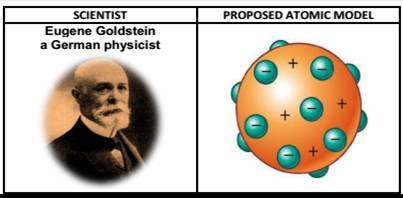
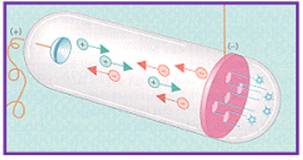
- E. Goldstein in 1886 discovered the presence of new radiations in a gas discharge and called them canal rays. These rays were positively charged radiations which ultimately led to the discovery of another sub-atomic particle.
- Used a Cathode Ray Tube to study “canal rays” which had electrical and magnetic properties opposite of an electron
- Canal Rays: The positively charged radiation produced in the discharge tube at low pressure and high voltage are called canal rays.
Protons
The canal rays have positively charged sub-atomic, particles known as protons (p).
- Rutherford’s Scattering Experiments:
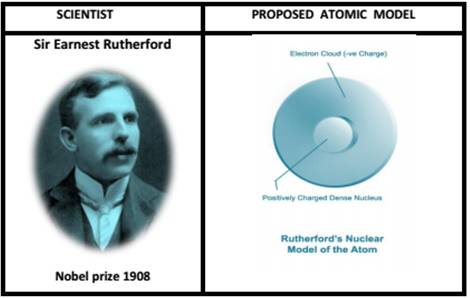
Experiment: Rutherford took a thin gold foil and made alpha particles, positively charged Helium fall on it.
| S.No. | OBSERVATION | INFERENCE |
| 1 | Most of the a-particles passed through the gold foil without getting deflected. | Most of the space inside the atom is empty. |
| 2 | Very few particles were deflected. | Positive charge of the atom occupies very little space. |
| 3 | A very few alpha particles, 1 in 100000completely rebound on hitting the goldfoil. | Nucleus of an atom is very small ascompared to the total size. |
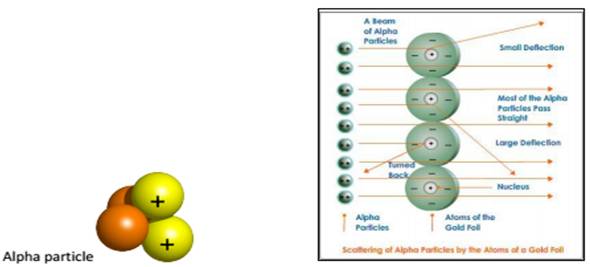
- Limitation: In Rutherford’s atomic model , Nucleus & electrons are held together by electrostatic force of attraction which would lead to the fusion between them. This does not happen in the atom.
Atomic radius ~ 100 pm = 1 x 10 m
Nuclear radius ~ 5 x 10 pm=
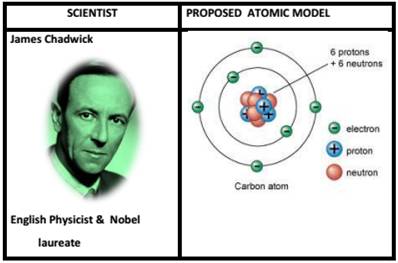
- In 1932, James Chadwick proved that the atomic nucleus contained a neutral particle which had been proposed more than a decade earlier by Ernest Rutherford officially discovered the neutron in 1932,
- Chadwick received the Nobel Prize in 1935.
A neutron is a subatomic particle contained in the atomic nucleus. It has no net electric, unlike the proton’s positive electric charge.
4. Sub Atomic Particles:
| Name | Symbol | Location in the atom | charge | Relative Mass | Actual Mass (g) |
| Electron | E | Around the nucleus | 1– | 1/1840 | |
| Proton | P | In the nucleus | 1+ | 1 | |
| Neutron | n | In the nucleus | 0 | 1 |
Protons & Neutrons collectively are known as NUCLEONS.
5. Atomic Number & Mass Number:
“Atomic number of an element is defined as the number of unit positive charges on the nucleus (nuclear charge) of the atom of that element or as the number of protons present in the nucleus.”
Atomic number, Z = Number of unit positive charge on the nucleus
= Total number of unit positive charges carried by all protons present in the nucleus.
= Number of protons in the nucleus (p)
= Number of electrons revolving in the orbits (e)
Eg :- Hydrogen – Atomic number = 1 (1 proton)
Helium – Atomic number = 2 (2 protons)
Mass number[ A] : It is defined as the sum of the number of protons & neutrons present in the nucleus of an atom.
Mass Number = Mass of protons + Mass of neutrons
Eg :- Carbon – Mass number = 12 (6 protons + 6 neutrons) Mass = 12u
Aluminium – Mass number = 27 (13 protons + 14 neutrons) Mass = 27u

6. Niel Bohr Atomic Model:
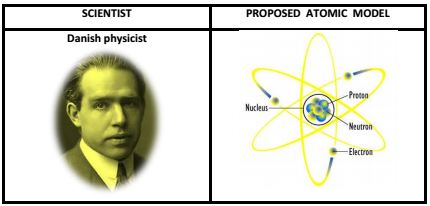
7. Electronic configuration & Valency:
Bohr and Bury Scheme – Important Rules
| S.No | where n = shell number | Maximum Capacity |
| 1 | K Shell 2 x (1) | 2 electrons |
| 2 | L Shell 2 x (2) | 8 electrons |
| 3 | M shell 2 x (3) | 18 electrons |
| 4 | N shell 2 x (4) | 32 electrons |
The outermost shell of an atom cannot accommodate more than 8 electrons, even if it has a capacity to accommodate more electrons. This is a very important rule and is also called the OCTET RULE. The presence of 8 electrons in the outermost shell makes the atom very stable.
8. Isotopes & Isobars
ISOTOPES
| ISOTOPES | ISOBARS |
| Chemically same, physically different | Chemically different, physically same |
| Number of electrons is same | Number of electrons is different |
| Cannot be separated by chemical means | Can be separated by chemical means |
Structure of the Atoms class 9 Notes
- CBSE Revision notes (PDF Download) Free
- CBSE Revision notes for Class 9 Science PDF
- CBSE Revision notes Class 9 Science – CBSE
- CBSE Revisions notes and Key Points Class 9 Science
- Summary of the NCERT books all chapters in Science class 9
- Short notes for CBSE class 9th Science
- Key notes and chapter summary of Science class 9
- Quick revision notes for CBSE exams
CBSE Class-9 Revision Notes and Key Points
Structure of the Atoms class 9 Notes. CBSE quick revision note for Class-9 Science, Chemistry, Maths, Biology and other subject are very helpful to revise the whole syllabus during exam days. The revision notes covers all important formulas and concepts given in the chapter. Even if you wish to have an overview of a chapter, quick revision notes are here to do if for you. These notes will certainly save your time during stressful exam days.
- Revision Notes for class-09 Mathematics
- Revision Notes for class-09 Science
- Revision Notes for class-09 Social Science
- Revision Notes for class-09 English Communicative
To download Structure of the Atoms class 9 Notes, sample paper for class 9 Mathematics, Social Science, Science, English Communicative; do check myCBSEguide app or website. myCBSEguide provides sample papers with solution, test papers for chapter-wise practice, NCERT solutions, NCERT Exemplar solutions, quick revision notes for ready reference, CBSE guess papers and CBSE important question papers. Sample Paper all are made available through the best app for CBSE students and myCBSEguide website.
- Matter in Our Surrounding class 9 Notes Science
- Is Matter around Us Pure class 9 Notes Science
- Atoms and Molecules class 9 Notes Science
- Structure of the Atoms class 9 Notes Science
- The Fundamental Unit of Life class 9 Notes Science
- Tissues class 9 Notes Science
- Diversity in Living Organisms class 9 Notes Science
- Motion class 9 Notes Science
- Forces and Laws of Motion class 9 Notes Science
- Gravitation class 9 Notes Science
- Work and Energy class 9 Notes Science
- Sound class 9 Notes Science
- Why Do We Fall ill class 9 Notes Science
- Natural Resources class 9 Notes Science
- Improvement in Food Resources class 9 Notes Science

Test Generator
Create question paper PDF and online tests with your own name & logo in minutes.
Create Now
myCBSEguide
Question Bank, Mock Tests, Exam Papers, NCERT Solutions, Sample Papers, Notes
Install Now
Awsome
Awesome, thanks so much for your service